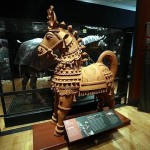While the relationship between horses and humans is one of public fascination and private intrigue, it is also something that evades easy description. Although many have tried to put words to the magical connection that can occur between an equine and his human, sometimes words are not enough. And for this reason, we often look to exhibits such as “The Horse” produced in partnership by the The Kentucky Horse Park’s International Museum of the Horse, and the American Museum of Natural History. For those interested in experiencing a visual depiction of horse and human collaboration, this exhibit is not to be missed. Here is the official press release:
Prestigious American Museum of Natural History Sends Its Blockbuster Exhibition to the International Museum of the Horse

LEXINGTON, Ky. (August 29, 2011) – The Kentucky Horse Park’s International Museum of the Horse (IMH), in collaboration with the American Museum of Natural History, announced today that it will host the exhibition, The Horse, from October 22, 2011, through April 6, 2012. The IMH is a major lender to the exhibition.
“We are thrilled to be able to bring this world-class exhibition to Kentucky,” said Bill Cooke, director of the Kentucky Horse Park’s International Museum of the Horse. “The American Museum of Natural History is truly one of the world’s great natural history museums, and they did a masterful job in developing an exhibition that not only illuminates the timeless union between humans and horses, but does so in an amazingly entertaining way. We are excited that this will be our first blockbuster-level exhibition while schools are in session. I have no doubt that both teachers and their students will love The Horse.”
From the horse’s earliest ancestors grazing on the plains of what is now Nebraska to a magnificent contemporary Deborah Butterfield horse sculpture, the eternal bond between horses and humans is explored in the largest equestrian traveling exhibition ever assembled. The Horse graphically portrays the horse’s impact on trade, transportation, labor, warfare, culture, and sports. It showcases spectacular fossils, models, dioramas, and cultural objects from around the world, including many from the American Museum of Natural History’s world famous collections.
The New York Times called this exhibition “charming and illuminating” and “an uplifting example of how horses enrich our lives.” The New York Post said, “You absolutely must see it.”
The Horse is divided into six major sections: The Evolution of Horses; Horses and Hunters; Domesticating Horses; The Nature of Horses; How We Shaped Horses and Horses Shaped Us; and An Enduring Bond. These themes are illuminated by more than 140 artifacts and cultural objects from around the world including a complete Samurai saddle from Japan, a full suit of 15th-century German horse armor, and Native American horse accoutrements. Bringing the exhibit to life are a stunning 220-square foot diorama that depicts the horse’s ancestors, a high-definition video that captures in slow motion the rippling muscles of a Thoroughbred race horse, and an interactive video of a life-size horse where visitors can investigate a horse’s pulmonary and digestive systems and other biological traits.
“This extraordinary, entertaining and informative exhibition is a perfect fit for the Kentucky Horse Park, which exists to celebrate man’s relationship with the horse, a relationship that has endured through the millennia,” said Kentucky Horse Park Executive Director John Nicholson. “This amazing and most beautiful of creatures has never lost its ability to look for the good – and bring out the best – in mankind as a partner, teammate and friend. That’s why we never lose our fascination with them, and why we are so excited to have this exhibition coming to our park.”
The Horse is organized by the American Museum of Natural History, New York, in collaboration with the Abu Dhabi Authority for Culture and Heritage, United Arab Emirates; the Canadian Museum of Civilization, Gatineau-Ottawa; The Field Museum, Chicago; and the San Diego Natural History Museum. Curator of the exhibition is Ross MacPhee.
“The human-horse relationship was almost predestined,” MacPhee said. “Puny but clever, enterprising humans needed an animate energy source that was both mobile and controllable – hence the domestic horse. What no one could have foreseen was that, over the millennia, while we molded the horse to our ends, the horse also molded us by changing the scale and scope of what could be carried, traded, fought over, or used to make life better – in short, civilization as we know it.”
For more information on The Horse, go to www.amnh.org/exhibitions/horse/, www.imh.org, or www.kyhorsepark.com.
Admission to The Horse is included with park admission, or a “museums only” ticket may be purchased for $8 for adults or $4 for children ages 7-12, which also includes admission to the entire International Museum of the Horse, the Al Marah Arabian Horse Galleries and the American Saddlebred Museum.
Park Hours and Rates: Through November 6, the park is open seven days a week. Admission is $16 for adults, $8 for children 7-12. From November 7 to March 14, the park is open Wednesdays through Sundays. Winter admission is $10 for adults and $5 for children ages 7-12. Children age 6 and under are always admitted free of charge. Admission includes the International Museum of the Horse – a Smithsonian Affiliate, and the American Saddlebred Museum.
The Kentucky Horse Park is a working horse farm/theme park and equine competition facility dedicated to man’s relationship with the horse. The park is an agency of the Kentucky Tourism, Arts and Heritage Cabinet that hosted more than one million visitors and campers, as well as 15,000 competition horses in more than 100 special events and horse shows in 2010. The park is home to the National Horse Center which comprises more than 30 national and regional equine organizations. Located at Exit 120, Interstate 75, just north of Lexington, the Kentucky Horse Park is the place to get close to horses.
Contact: Cindy Rullman
859-259-4209
Cindy.Rullman@ky.gov